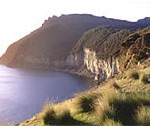Friends of Maria Island
Our group developed from an initial involvement in the renovation of historic farm buildings, but now has broadened towards sustaining the long term future of the island’s ecosystems as well as it’s cultural heritage. We came together through a common interest in preserving the environment and heritage of the island.
Where we work
 Maria Is. is located off the East coast of Tasmania, accessed by ferry from Triabunna.
Maria Is. is located off the East coast of Tasmania, accessed by ferry from Triabunna.
This spectacular island National Park (declared in 1972) has a rich history reaching back many thousands of years. Millennia of aboriginal seasonal visits; some of the earliest European exploration of Australia; an intriguing episode of convict settlement; industrial projects and agriculture, have all left a fascinating legacy. All this, together with a complex geology, dramatic landforms and a relatively intact, isolated ecosystem, supporting abundant wildlife (including a number of endangered species) makes for a unique environment.
Who we are
Our group developed from an initial involvement in the renovation of historic farm buildings, but now has broadened towards sustaining the long term future of the island’s ecosystems as well as it’s cultural heritage We came together through a common interest in preserving the environment and heritage of the island. All are welcome.
What we do
The greatest threat to the island’s ecosystems are Canary broom (Genista monspessulana) and Spanish Heath (Erica lusitanica); our main focus is on controlling these weeds with the long term goal of eradicating them. Parks and Wildlife provide guidance and assistance. We have been successful in obtaining Government grants to assist with the work. 3 or 4 ‘working bees’ are organized each year.
There are also opportunities to work with Parks and Wildlife on Cultural sites and other projects.
Accommodation with cooking facilities is provided (or camping if preferred)
Our Contacts
President: Anne Booth, annegbooth@gmail.com